A firearm is a portable gun – a barreled weapon that launches one or more projectiles, often driven by the action of an explosive force caused by pressure during the discharge of ammunition. The first primitive firearms originated in 13th-century China when the one-person-portable fire lance was combined with projectiles.
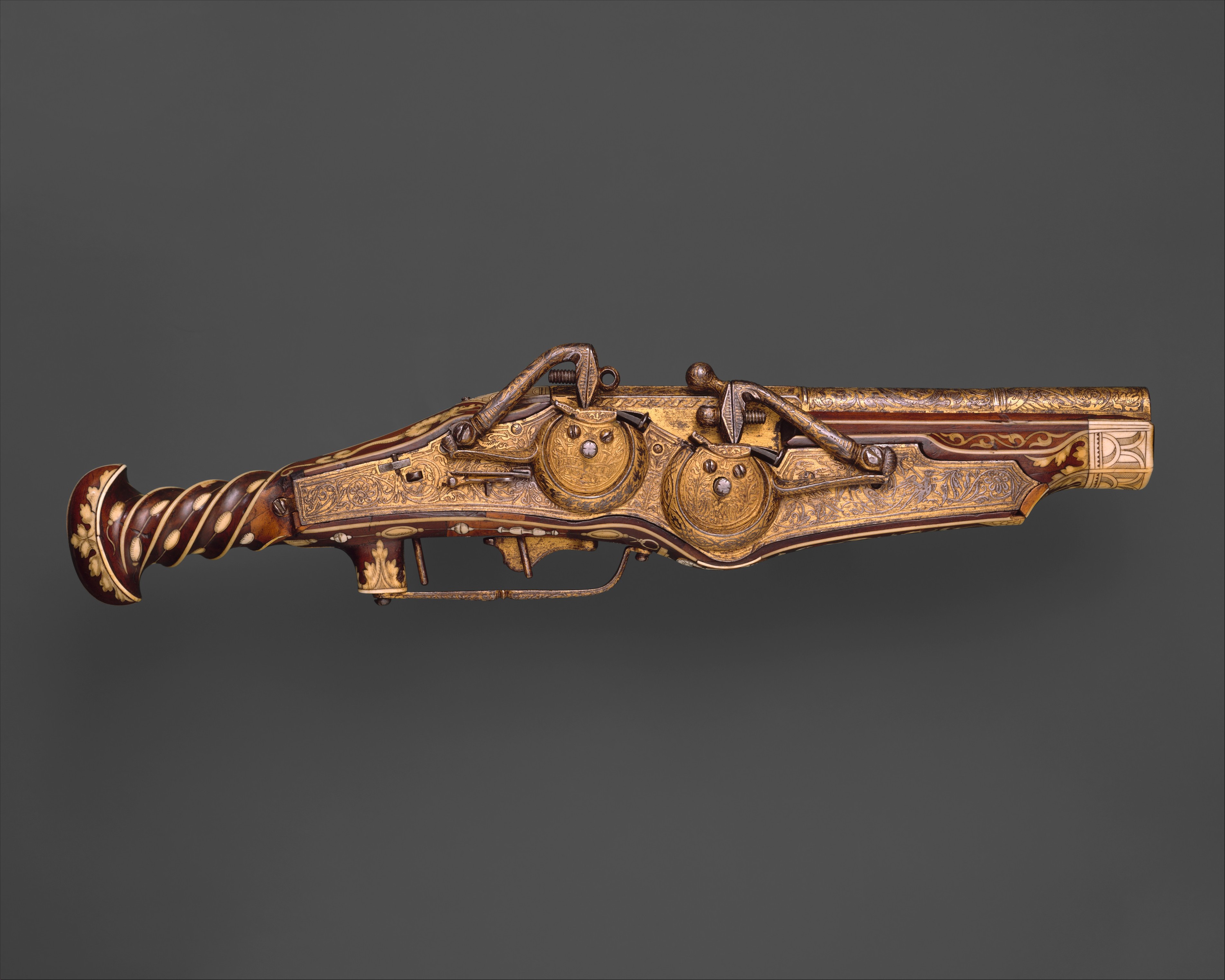
image source: https://search.creativecommons.org/photos/f9a23c1a-9ca8-4127-94a5-99bf4735ecfd
What is a Firearm?
A firearm is a mechanical device which through the pressure of a burning powder or an explosive charge can force a bullet through and out of a metal tube; a weapon capable of firing a projectile and using an explosive charge as a propellant.
The components and terms used for weapon parts have changed very little. All firearms have three basic groups of parts.
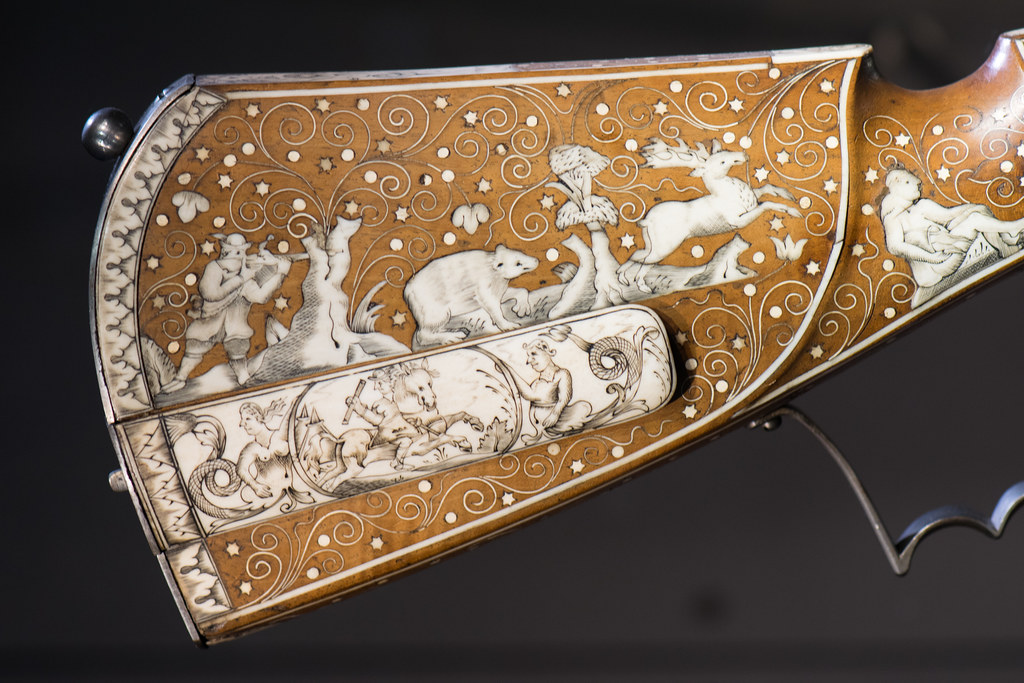
image source: https://search.creativecommons.org/photos/d4d34f30-2d90-4b77-a345-b74f550a0b40 by quinet
- Action: The action is the heart of the firearm-the moving parts that load, fire, and eject bullets or cartridges. Several types of actions are used in modern firearms. Muzzleloaders have locks, consisting of the hammer (rooster) and a flash plate that contained the powder, instead of the actions.
- Stock: The stock acts as a handle or support for the firearm. It can be made up of one or two pieces and is usually made of wood or a synthetic material.
- Barrel: The barrel is the metal tube through which the bullet travels.

image source: https://search.creativecommons.org/photos/98eb468a-42eb-4495-aea6-4b6bc3a572c1 by quinet
Ammunitions
The basic components of ammunition are:
- Case: All the other ammunition components are held together inside in brass, steel, copper, paper, or plastic.
- Primer: An explosive chemical compound which, if hit by a firing pin, can ignites gunpowder and can be placed both in the rim of the case (rim-fire) or in the center of the base of the case (center-fire).
- Gunpowder: Chemical mixture capable of burning very quickly and when ignited it converts into an expanding gas. When lit outdoors, modern smokeless powder burns slowly, while black powder can be explosive when lit outdoors.
- Projectile: The object or objects ejected from the barrel, usually coated with lead or copper and fired through the barrel of a rifle or pistol. The shot is a group of lead, steel, tungsten, or bismuth shots fired through a gun barrel.
Who invented the gunpowder?

image source: https://search.creativecommons.org/photos/aa5bc9f9-58be-4f34-bcab-3c8e58765fea by JoshBerglund19
The discovery of gunpowder in China was an accident. Contrary to myth, it was not only used for fireworks it was also for military uses. Eventually, this secret weapon leaked to the rest of the medieval world.
Ancient alchemists in China spent centuries trying to discover an elixir of long life that would make those who use it immortal.
During the Tang Dynasty, around 850 A.D., an enterprising alchemist mixed 75 parts of saltpeter with 15 parts coal and 10 parts sulfur. This mixture had no life-extending properties, but it exploded with a flash and a bang when exposed to an open flame.
Who invented the first gun?
It all started in China, where gunpowder was created. In the 9th century, alchemists mixed coal, saltpeter, and sulfur into a powder called huo yao, which was used to treat skin infections. Armies learned that the powder could be used in bombs, mines, and other weapons. Gunpowder was transported to Europe in the 13th century, possibly via the Silk Road trade routes through central Asia. Rival nations perfected their gunpowder recipes before coming up with the optimum blend: about 75 percent saltpeter, 15 percent charcoal, and 10 percent sulfur.
Historians recognize Chinese firearms invented in the 10th century, as the first firearms. These bamboo or metal tubes cast flames and splinters on their targets. Cannons appeared in Italy around 1320, where they were modified as European nations fought many wars. By the 16th century, European firearms had become much more advanced than their counterparts in the East.
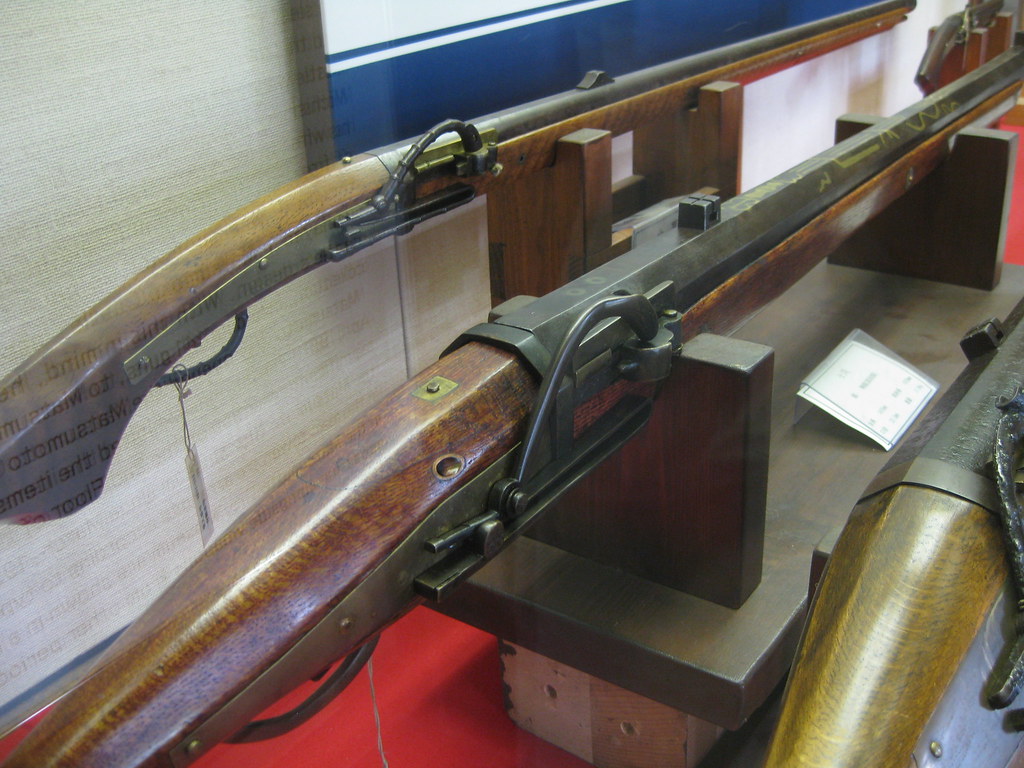
image source: https://search.creativecommons.org/photos/33232b4e-8fb7-47b2-9463-fac762ba74a8 by ryochiji
Guns slowly replaced old-guard weapons, because they were cheaper. Firearms have had a far-reaching influence on the nature of armed combat, from the distances at which dueling armies clash to the types of injuries sustained. Only the horse which has dominated the battlefields for millennia has proved more important than the rifle.
How were the first firearms made?
The earliest record describing the combination of coal, sulfur, and saltpeter is a coded script by the Franciscan monk Roger Bacon shortly before 1250 A.D.
Within 50 years, early cannon had been developed. A large thick metal tube with a closed-end (the breech) and an open-end (the muzzle) was loaded first with gunpowder and then with a bullet. The powder was ignited with a torch or a glowing ember through a small hole in the back (the touchhole). The rapidly expanding gases would throw the bullet out of the barrel. This basic principle still applies today.
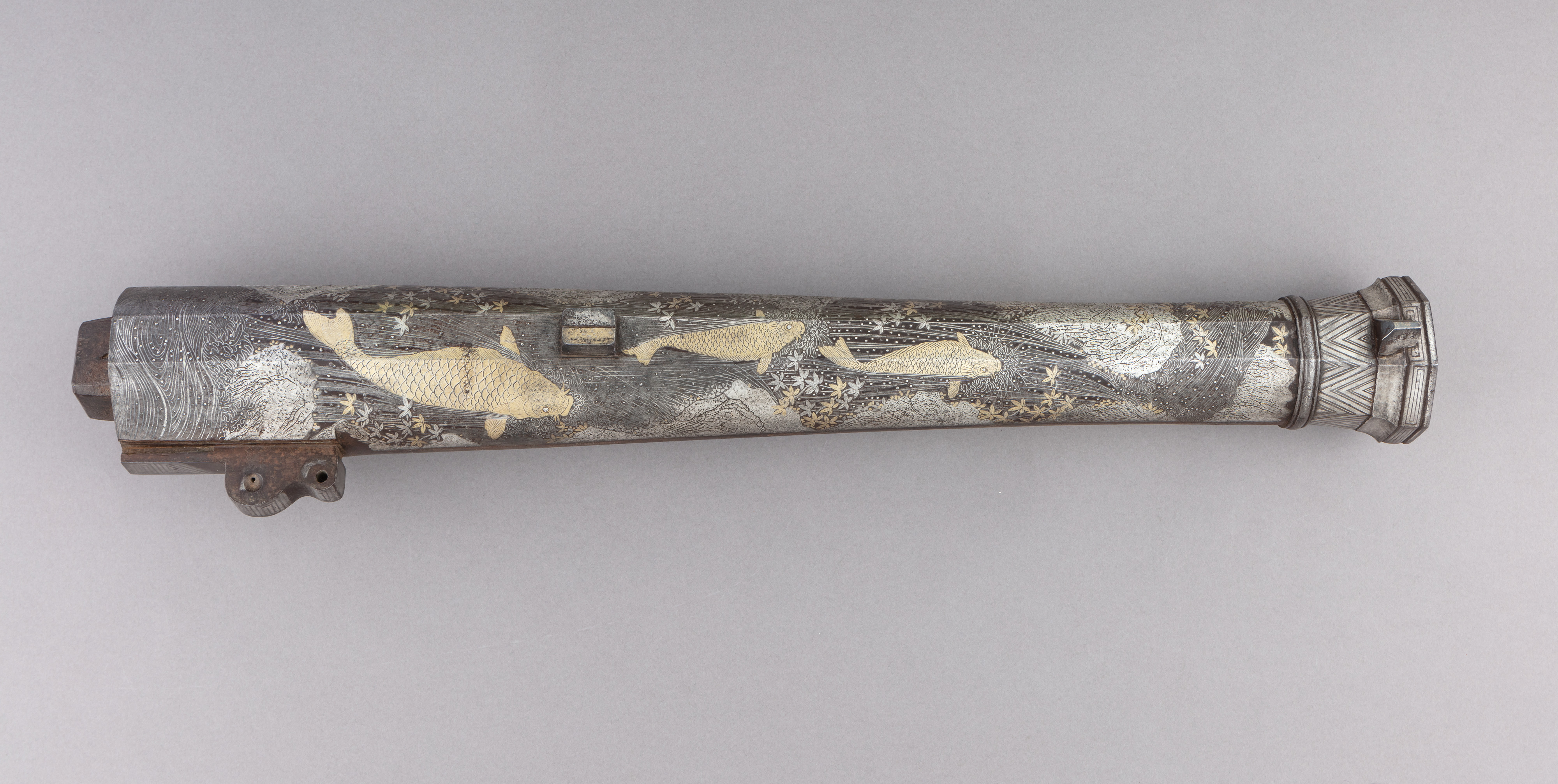
image source: https://search.creativecommons.org/photos/5eeb7763-23cb-4c3c-a94d-3afa507461d8
It took another half a century for this concept to be applied to individual small arms. The first firearms, ca. 1350, called “hand cannons” or “hand gonnes,” were miniature cannons designed to be held by hand or attached to a pole for use by individual soldiers. They were loaded and fired in the same way as full-size cannons.
When was the first time that firearms were used in a battle?
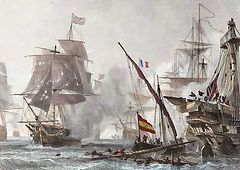
image source: https://en.wikipedia.org/wiki/Algeciras_campaign#/media/File:Bataille_algesiras.jpg
During the Reconquest of Spain, the Siege of Algeciras (1342–44) was undertaken by the Castillian forces of Alfonso XI assisted by the fleets of the Kingdom of Aragon and the Republic of Genoa. The goal was to capture the Muslim city of Al-Jazeera Al-Khadra, the capital and the main port of the European territory of the Marinid Empire. In this first military engagement in Europe, gunpowder was used.
The siege lasted twenty-one months. The population of the city, about 30,000 civilians and Berber soldiers, suffered a blockade preventing the entry of food into the city. To relieve the city, the Emirate of Granada sent an army that was defeated near the Río Palmones. The city surrendered on 26 March 1344 and was incorporated into the Kingdom of Castile.
How did firearms evolved over time?

1364 – First documented use of a firearm.
1380 – Handguns are known throughout Europe.
1400 – The matchlock gun appears.
Before the matchlock, guns were fired by holding a lit wick into a “contact hole” in the barrel that ignited the powder inside. The first device, or “lock,” for mechanically firing a gun is the matchlock. The powder is held in a “flash pan,” and ignited by a wick in a movable clamp. Both hands remain on the gun, improving aiming. The first matchlock guns are extremely rare.
1498 – The principle of rifling is discovered.
1509 – Invention of wheel lock (rose lock).
The progress of the wheel lock mechanically generates a spark. With no wick to keep on, the wheel lock is easier to use, and more reliable than the matchlock but more expensive to manufacture. This is one of the first multi-shot pistols (ca. 1540) with a wheel-lock made for Emperor Charles V. In this weapon, two locks are combined in one mechanism, to give each barrel separate ignition.

1540 – The rifling appears in firearms.
1607 – Settlers arrive in Jamestown, Virginia.
1630 – The first real flintlock.
In the late 1500s, a lid was added to the flash pan design, and to expose or protect the dust, the lid had to be moved manually. The flintlock mechanism allowed you to push the lid back and ignite a flint at the same time. This system reigned for two centuries.
 1637 – First use of firearms test marks.
1637 – First use of firearms test marks.
1750-1850 – Dueling pistols come into fashion.
Around 1750, pistols became the weapon of choice for a duel. Various guns were used, until a true dueling pistol was officially standardized in 1777, as “a smooth-bore 9 or 10-inch flint with 1-inch bore, carrying a ball of 48 per pound.” Often richly decorated, the pistols are made until duel falls from grace in the mid-1800s. This pair of 1786 flintlock pistols were crafted with ivory butts and elaborate decorative details.

1776 – American Revolution.
1807 – Patented detonating percussion principle.
1825 ca. – Percussion pistols are for general use.
1830 – The reverse action block is displayed.
1835 – The first Colt revolver.
Samuel Colt developed the first mass-produced, multi-shot, revolving firearms. However, it was not possible to make precision parts with the available technologies. Colt was the first to apply the machining tools of the Industrial Age thus making guns affordable through mass production. Reliability and precision have made the Colt a favorite of soldiers and frontiersmen.
 1840 – Guns begin to use pin-fire cartridges.
1840 – Guns begin to use pin-fire cartridges.
1847 – The telegraph is invented.
1850 – Real rifles in common use.
In the second half of the 18th century, the musket design branched out. This period produced several single-use firearms. The forerunner of modern shotguns was the hunting piece, developed specifically for bird hunting. Fowling pieces were often works of art but impractical.
 1854-56 – The Crimean War. The last war to use only muzzle-loaded weapons.
1854-56 – The Crimean War. The last war to use only muzzle-loaded weapons.
1859 – The first complete rimfire cartridge.
1860 – Spencer repeating rifle patented.
Introduced at the start of the Civil War, Spencer repeating pistols were technically advanced, used cartridges, and could fire 7 rounds in 15 seconds. But the military, fearing that soldiers would fire more often and that they constantly needed new ammunition, overloading the supply system, did not want repeater guns. But in 1863, President Lincoln had a Spencer tested, his approval led to the purchase of 107,372 Spencer repeating carbines and rifles becoming the leading repeater of the Civil War.
 1861 – Commonly used breech-loading pistols.
1861 – Commonly used breech-loading pistols.
1861-1865 -American Civil War. Use both breech and muzzle loading pistols.
1862 – The Gatling Gun is invented.
1869 – Introduction of the center-fire cartridge.
1870-1871- The Franco-German War. Breach-loaded weapons are dominant.
1871 – First cartridge revolver.
1873 – The Winchester rifle is introduced.
Winchester rifles were affordable and produced in large quantities to become generic rifles. In some regions, it became known as “the weapon that conquered the West.” In 1887, Winchester came out with their first repeating rifles. In 1903, the company introduced the first automatic rifle.
 1876 – Custer is defeated at Little Big Horn.
1876 – Custer is defeated at Little Big Horn.
1877 – First effective double-action revolver.
1879 – Lee box magazine patent.
1892- Advent of automatic pistols.
Joseph Laumann in 1892 created the first automatic pistol. But the Borchardt pistol of 1893 was the first automatic with a separate magazine in the handle. More automatics arrived, including the Browning, Luger, Mauser, and Colt models. At the turn of the century, just 8 years after Laumann, automatics were firmly established.
1900 – The historical period of firearms ends. The contemporary period begins.
Image source: http://www.pbs.org/opb/historydetectives/technique/gun-timeline/
Info source:
http://www.americanfirearms.org/what-is-a-firearm/
https://www.thoughtco.com/invention-of-gunpowder-195160
http://science.howstuffworks.com/innovation/inventions/who-invented-the-first-gun.htm
http://www.nramuseum.com/gun-info-research/a-brief-history-of-firearms.aspx
http://blog.xfree.hu/myblog.tvn?SID=&kat=1693&n=vg999&blog_kategoria=T%FBz%E9rs%E9g,%20tankok
https://www.revolvy.com/topic/Siege%20of%20Algeciras%20(1342-1344)&item_type=topic
http://www.pbs.org/opb/historydetectives/technique/gun-timeline/

Comments are closed.